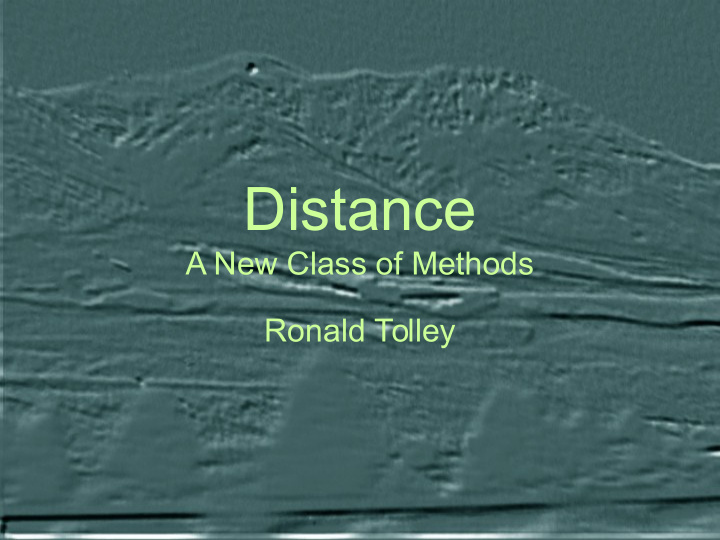



Distance A New Class of Methods Ronald Tolley
AI Assessment “[Various aspects of] artificial [intelligence] … have skewed off … to find specialized niches … “Text recognition and document scanning are … beginning to provide a significant new input medium for computer systems. “… the original vision of creating a true, humanlike intelligence that started so much of this research remains as unrealized as ever.” Hogan, Mind Matters , p. 199
Distance Assessment • Overall AI assessment • FH domain – Match / Merge Consolidation • Non-FH domains • Contrast FH and classical AI applications • Contrast machine and human methods • Corridor methods
Distance Example 1 KELLOGG KELLOGG Moses Moses b b b Massachusetts b m Lydia KELLOGG m Mary SHELDON m about 1748 m 30 Apr 1740 m m d d d d Massachusetts
Distance Example 2 FISHER FISHER William William b b b Devon, England b Devon, England m Sarah Warren m Sarah Gadd m 1 Apr 1849 m 11 Jan 1869 m m d d d Nephi, Utah d probably Idaho
Family History versus Classical AI • Recorded with intent • No resampling possible • Missing / occulted data • Definitive structure – complexity in resolving issues • Back story … back story … back story
Three Images
Three Images
Three Images
Three Top Strips
Three Middle Strips
Three Bottom Strips
Short Image Sequence
Long Sequence
Missing Elements: Occultation • Human visual field – unifying fragments • McCloud – closure • Restak – fill-in • Hogan – emergent properties
Missing Elements: Closure • Human visual field – unifying fragments • McCloud – closure • Restak – fill-in • Hogan – emergent properties
Compare: machine, human Classical AI Classical Human • High Leverage • Low Leverage • Strong Methods • “Weak” Methods • Very Precise Criteria • Imprecise Criteria • Exacting Evaluation • Arbitrary Evaluation • Reductivistic • Non-reductivistic – simplicity – complexity – Occam – Rube Goldberg • Uncertainty • Uncertainty – handled as defect – Fill in missing data – Closure
Contrast: machine, human Classical Human Classical AI • Syntactic methods in pattern recognition • Limited by time, money, • Statistic methods in pattern recognition • Self-Organizing systems energy, patience • Image processing • • Feature extraction Persistence • Comparison • Symbol manipulation / LISP / List Processing • Pattern matching • Parallels, metaphors, • Games / Decision Trees / Searches models, analogies – pruning – combinatorix • Negotiation • Chess / Music / Mathematics • Data mining – concession ladder • Dualism / Pumps • Natural languages / Translation • Tool collectors – Eliza • Semantic nets / associative nets • Common sense • Neural nets • Expectation • Self-modifying code / Genetic programming • Models / Metaphors / Analogies / Parallels – foresight • Distances / Models / Methods / Contexts • Probabilities • Belief – Bayes theorem
New Taxonomy within AI • Handling of Missing / Occulted data • Concentration / Distribution of Features • Graphical and symbolic processing – Blurring the borderline • Parallelism / Metaphors • Limited Reductivism • Holographic leads to • Corridor Methods
Conclusions • Artificial Intelligence – niche applications – no generalized solutions • Unique human “fill-in” ability – deal with hidden / occulted data – reach closure • Corridor Methods
Recommend
More recommend